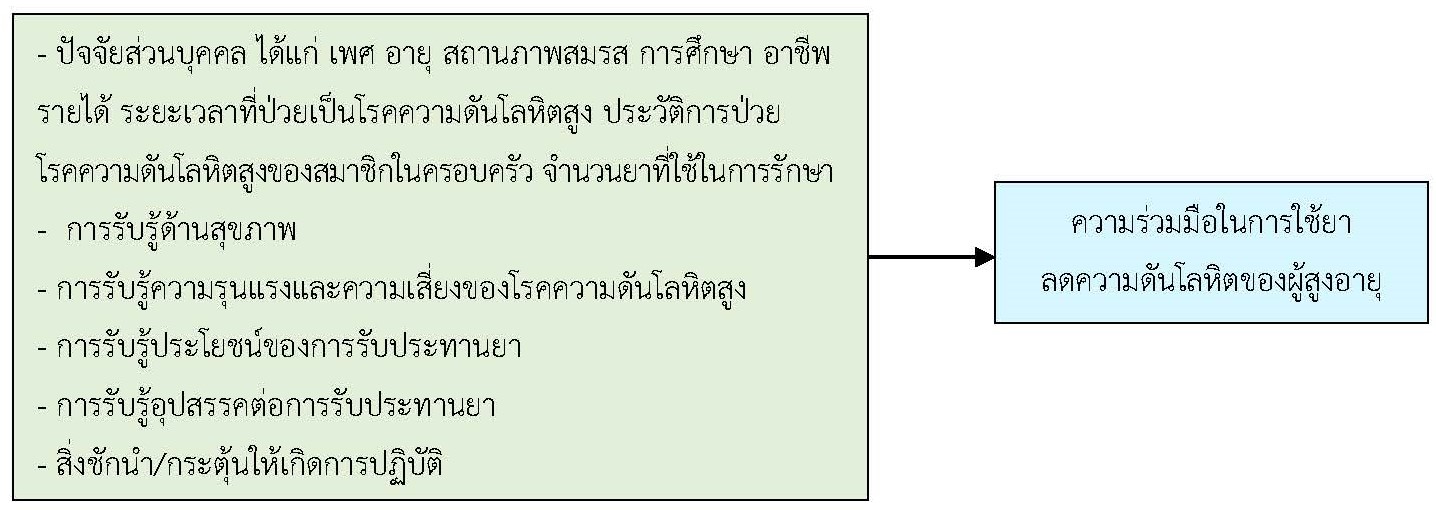Health Perception and Medication Adherence of Older Adults with Uncontrolled Hypertension
Keywords:
Medication Adherence, Health Perception, Hypertension, Older AdultsAbstract
The objectives of this mixe-method research were to explore health perception, medication adherence, and factors associated with medication adherence among uncontrolled hypertensive older adults in Don Ko Ka Subdistrict, Bang Nam Priao District, Chachoengsao Province. Quantitative data was collected from 85 older adults aged 60 years and over with uncontrolled hypertension, selected by purposive sampling. Qualitative data was collected through in-depth interviews with 20 older adults having medication non-adherence issues. Research instruments included a general information questionnaire, a health perception questionnaire, a medication adherence for hypertension questionnaire, and a semi-structured interview on health perception. Quantitative data was analyzed using descriptive statistics and the chi-square test, while qualitative data was analyzed using content analysis.
The results revealed that the top three medication non-adherence problems were missing doctor appointments, forgetting to take medicines, and not taking medicines on time. Older adults had an overall high level of health perception (Mean = 3.68, S.D. = 0.36). Gender was associated with self-adjusting medication doses (p-value < 0.05). Age was associated with missing doctor appointments (p-value < 0.05). The duration of illness was associated with missing doctor appointments (p-value < 0.05) and medication non-adherence due to missed appointments (p-value < 0.05). Therefore, healthcare personnel should consider personal factors associated with medication adherence. Also, healthcare facilities should provide a pharmacist counseling system and regular medication education at the hospital.
References
กมลชนก จงวิไลเกษม และสงวน ลือเกียรติบัณฑิต. (2562). การพัฒนาแบบวัดความร่วมมือในการใช้ยาสำหรับ คนไทย. วารสารเภสัชกรรมไทย, 13(1), 17-30.
กระทรวงสาธารณสุข. (2566). Dashboard Health KPI: ร้อยละของผู้ป่วยโรคความดันโลหิตสูงที่ควบคุมได้.สืบค้นเมื่อ 10 ตุลาคม 2566 จาก http://healthkpi.moph.go.th/kpi2/kpi-list/view/?id=168.
กองโรคไม่ติดต่อ กรมควบคุมโรค (2564). รายละเอียดตัวชี้วัดเพื่อกำกับติดตามคุณภาพบริการการดำเนินงาน ด้านโรคไม่ติดต่อ (โรคเบาหวานและโรคความดันโลหิตสูง) ประจำปีงบประมาณ พ.ศ.2565. สืบค้นเมื่อ 20 ตุลาคม 2566 จาก https://ddc.moph.go.th/uploads/publish/1186620211006043036.pdf.
ชมพูนุท พัฒนจักร. (2560). ความร่วมมือในการใช้ยาของผู้ป่วยสูงอายุโรคเรื้อรัง ในเขตพื้นที่บริการโรงพยาบาลส่งเสริมสุขภาพตำบลลาดพัฒนา อำเภอเมือง จังหวัดมหาสารคาม. วารสารโรงพยาบาลมหาสารคาม, 16(3), 13-22.
ณัฐนันท์ คำพิริยะพงศ์ และศิริพันธุ์ สาสัตย์. (2560). ผลของโปรแกรมความเชื่อด้านสุขภาพต่อพฤติกรรมการใช้ยาในผู้สูงอายุโรคความดันโลหิตสูง. วารสารแพทย์นาวี, 44(3), 67-83.
ดาลิมา สำแดงสาร, ทิพมาส ชิณวงศ์ และเพลินพิศ ฐานิวัฒนานนท์. (2562). ปัจจัยที่มีความสัมพันธ์กับความร่วมมือในการรักษาของผู้สูงอายุโรคความดันโลหิตสูง. วารสารพยาบาลสงขลานครินทร์, 39(3), 51-66.
ทรงวุฒิ สารจันทึก. (2564). ผลการประเมินปัญหาการใช้ยาและพฤติกรรมการดูแลตนเองของผู้ป่วยโรคเรื้อรัง โดยการเยี่ยมบ้านแบบ INHOMESSS ในเครือข่ายบริการสุขภาพ อำเภอวังม่วง จังหวัดสระบุรี. วารสารวิจัยและพัฒนาด้านสุขภาพ สำนักงานสาธารณสุขจังหวัดนครราชสีมา, 7(2), 233-247.
ธราดล โพธิษา, น้ำเงิน จันทรมณี และทวีวรรณ ศรีสุขคำ. (2564). ปัจจัยทำนายความร่วมมือในการใช้ยาของผู้ป่วยโรคความดันโลหิตสูงในชุมชนแห่งหนึ่งของจังหวัดพะเยา. วารสารเภสัชกรรมไทย, 13(2), 400-411.
ธัญรดี ปราบริปู. (2564). ปัจจัยที่มีความสัมพันธ์กับพฤติกรรมการใช้ยาของผู้ป่วยโรคความดันโลหิตสูงที่มารับบริการที่คลินิกพิเศษ โรงพยาบาลภูมิพลอดุลยเดช. วารสารวิทยาลัยพยาบาลพระปกเกล้า จันทบุรี, 32(2), 184-194.
นฤมล สบายสุข และลำพรรณ แสนบิ้ง. (2566). การพัฒนาระบบการดูแลผู้ป่วยโรคความดันโลหิตสูงผิดนัด. วารสารสุขภาพและสิ่งแวดล้อมศึกษา, 8(2), 465-477.
บุญชม ศรีสะอาด. (2560). การวิจัยเบื้องต้น (พิมพ์ครั้งที่ 10). กรุงเทพฯ: สุวีริยาสาส์น.
ปณิตา ลิมปะวัฒนะ และมัญชุมาส มัญจาวงษ์. (2564). โรคความดันโลหิตสูงในผู้สูงอายุ. วารสารอายุรศาสตร์ มหาวิทยาลัยขอนแก่น, 7(1), 17-23.
พุทธชาด ฉันทภัทรางกูร. (2566). ปัจจัยที่มีความสัมพันธ์กับความร่วมมือในการใช้ยาของผู้ป่วยนอกโรคเบาหวานชนิดที่ 2 และความดันโลหิตสูง โรงพยาบาลบางสะพาน จังหวัดประจวบคีรีขันธ์. วารสารเภสัชกรรมคลินิก, 29(1), 13-24.
ระบบคลังข้อมูลด้านการแพทย์และสุขภาพ กระทรวงสาธารณสุข. (2566). กลุ่มรายงานมาตรฐาน: อัตราป่วย ด้วยโรคความดันโลหิตสูงต่อประชากร. สืบค้นเมื่อ 15 ตุลาคม 2566 จากhttps://hdcservice.moph.go.th/hdc/reports/report.php &cat_id=6a1fdf282fd28180eed7d1cfe0155e11&id=6b9af46d0cc1830d3bd34589c1081c68.
รุ่งทิวา ขันธมูล และสมจิต แดนสีแก้ว. (2560). การจัดการตนเองของผู้ป่วยความดันโลหิตสูงที่ควบคุมความดันโลหิตไม่ได้. วารสารการพยาบาลและการดูแลสุขภาพ, 35(2), 89-97.
โรงพยาบาลจุฬาลงกรณ์. (2561). ภาวะแทรกซ้อนจากโรคความดันโลหิตสูง. สืบค้นเมื่อ 12 พฤศจิกายน 2566 จาก https://chulalongkornhospital.go.th/kcmh/ภาวะแทรกซ้อนจากโรคความ/.
โรงพยาบาลบางน้ำเปรี้ยว. (2564). การประชุมสรุปผลงานประจำปี 2564, สรุปโรคหลอดเลือดสมอง ปี 2564. ฉะเชิงเทรา: โรงพยาบาลบางน้ำเปรี้ยว.
วรารมย์ จิตอุทัย. (2564). ปัจจัยที่มีอิทธิพลต่อความร่วมมือในการรับประทานยาของผู้ป่วยโรคความดันโลหิตสูง ที่ไม่มีภาวะแทรกซ้อน. วิทยานิพนธ์พยาบาลศาสตรมหาบัณฑิต สาขาวิชาการพยาบาลผู้ใหญ่และผู้สูงอายุ คณะพยาบาลศาสตร์ มหาวิทยาลัยบูรพา.
ศศิธร รุ่งสว่าง. (2560). ปัจจัยที่มีความสัมพันธ์กับความร่วมมือในการใช้ยาหลายขนานของผู้สูงอายุโรคเรื้อรัง. วารสารพยาบาลศาสตร์ มหาวิทยาลัยสยาม, 18(35), 6-22.
สมาคมความดันโลหิตสูงแห่งประเทศไทย. (2562). แนวทางการรักษาโรคความดันโลหิตสูงในเวชปฏิบัติทั่วไป พ.ศ. 2562. เชียงใหม่: ทริค ธิงค์.
Becker, M. H. & Maiman, L. A. (1974). The health belief model and sick role behavior. In Becker M. H. Becker (Ed.), The health belief model, and personal health behavior (pp.82-92). New Jersey: Charles B. Slack, Inc.
Creswell, J. W. & Plano Clark, V. L. (2018). Designing and conducting mixed methods research (3 ed.). Los Angeles: SAGE Publications, Inc.
Musini, V. M., Tejani, A. M., Bassett, K., Puil, L. & Wright, J. M. (2019). Pharmacotherapy for hypertension in adults 60 years or older. Cochrane Database of Systematic Reviews, 6(6), 1-99. https://doi.org/10.1002/14651858.CD000028.pub3
Paisansirikul, A., Ketprayoon, A., Ittiwattanakul, W. & Petchlorlian, A. (2021). Prevalence and associated factors of drug-related problems among older people: A cross-sectional study at King Chulalongkorn Memorial Hospital in Bangkok. Drugs Real World Outcomes, 8(1), 73-84. https://doi.org/10.1007/s40801-020-00219-2
Punnapurath, S., Vijayakumar, P., Platty, P. L., Krishna, S. & Thomas, T. (2021). A study of medication compliance in geriatric patients with chronic illness. Journal of Family Medicine and Primary Care, 10(4), 1644-1648. https://doi.org/10.4103/jfmpc.jfmpc_1302_20
World Health Organization. (2003). Adherence to long-term therapies: Evidence for action. Retrieved October 9, 2023 from http://www.who.int/chronic_conditions/adherencereport/en/.
World Health Organization. (2023). Hypertension. Retrieved November 9, 2023 from https://www.who.int/news-room/fact-sheets/detail/hypertension.
Zhang, Y., et al. (2018). Factors affecting medication adherence in community-managed patients with hypertension based on the principal component analysis: Evidence from Xinjiang, China. Patient Prefer Adherence, 12, 803-812. https://doi.org/10.2147/PPA.S158662

Downloads
Published
How to Cite
Issue
Section
License
Copyright (c) 2024 Journal of Nursing and Public Health Research

This work is licensed under a Creative Commons Attribution-NonCommercial-NoDerivatives 4.0 International License.
1. บทความหรือข้อคิดเห็นใด ๆ ที่ปรากฏในวารสารวิจัยการพยาบาลและการสาธารณสุข ที่เป็นวรรณกรรมของผู้เขียน บรรณาธิการไม่จำเป็นต้องเห็นด้วย
2. บทความที่ได้รับการตีพิมพ์ถือเป็นลิขสิทธิ์ของ วารสารวิจัยการพยาบาลและการสาธารณสุข








